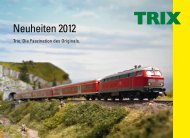Brawa - Micro Macro Mundo
Brawa - Micro Macro Mundo
Brawa - Micro Macro Mundo
You also want an ePaper? Increase the reach of your titles
YUMPU automatically turns print PDFs into web optimized ePapers that Google loves.
*<br />
THE DETAILS SHOULD STIR THINGS UP QUITE A BIT<br />
METAL STEPS<br />
NEW BODY WITH<br />
SMALL SILOS<br />
37104<br />
Order no.<br />
EXTRA BRAKE TRIANGLES AND<br />
LIFTING HOOPS<br />
MANY FREE STANDING<br />
FITTINGS AND HANDLES<br />
SHORT COUPLING KINEMATICS;<br />
COUPLING COMPATIBLE TO LENZ<br />
Cement Silo Car Kds 54 DB, with hand-brake platform<br />
Road no. 359 497<br />
a manner remained unchanged and only the dead weight was increased.<br />
Compared with the total number of more than 1,000 waggons built, Kds 54<br />
waggons equipped with a hand brake were relatively rare.<br />
AVAILABLE<br />
To make parked waggons safer, some of the Kds 54 waggons were equipped<br />
with a handbrake that could be operated on the platform. Unlike the Deutsche<br />
Bundesbahn‘s other newly constructed railway goods waggons, whose<br />
hand-brake platforms were bolted to the subframe, here they were directly<br />
integrated. In this way, the length over buffers of waggons equipped in such<br />
SPRING BUFFERS<br />
LAYOUT VERSION<br />
Cement Silo Car Kds 54 DB, with hand-brake platform<br />
Road no. 359 490<br />
37105<br />
Order no.<br />
Cement Silo Car Ucs 908 DB<br />
Road no. 21 80 910 5 712-3<br />
cars to DB for inspection in 1953. Since they still had a<br />
Hik braking system, they were designated Kd 54. They<br />
also had a dual link suspension system, as did the next<br />
150 cars from Talbot and Westwagon. Because of this,<br />
coupled with the very special undercarriage construction<br />
of the Kds 54, all subsequent deliveries received a simple<br />
link suspension system. After only 50 cars had been<br />
made, the container volume was 27 m³. The cars proved<br />
so useful that a total of 1222 Kds 54s were ordered by<br />
1964. In addition, a car was designed with a tank of 34<br />
m³ capacity and put into service as the Kds 56. In contrast<br />
to the Kds 54, which was rIv-compatible, the Kds 56<br />
could only be used internationally under special agreements.<br />
In addition to DB, private adjuster cars of this<br />
type were produced as well, for example, the animal<br />
feed mill „Albert O. Petersen“ („Club Mast“), varta and<br />
Heidezement.<br />
AVAILABLE<br />
After 1945, the vast destruction of residential buildings<br />
and infrastructure led to a high demand for the transport<br />
of building materials. Due to the number of buildings<br />
that needed to be replaced and the lack of manpower,<br />
the order of the day was to build fast and cheap. Thus,<br />
concrete was the building material of this period – this<br />
also occurred before the war, but not the same extent.<br />
One of the most important components, cement, was<br />
almost exclusively packed in paper bags and transported<br />
in covered trucks. This process was time-consuming and<br />
expensive. Tank cars for powdered materials such as coal<br />
dust had been available for some time, but their use was<br />
limited at that point to a few private adjusters. One of<br />
the reasons was that it was very difficult to completely<br />
empty the cargo, which caused many interruptions in<br />
loading and unloading. DB, jointly with the railcar industry,<br />
developed a new two-axle powder tank car with two<br />
standing containers. Westwaggon delivered the first ten<br />
With the introduction of the 12-digit UIC number, the Kds 54 waggons were among railway enthusiasts because of the various tractive units used by MEG.<br />
renumbered in Ucs908. Even while the Ucs909 waggons were still being procu- Since then DB Schenker itself has reduced its stock to very few vehicles. At the<br />
red, a number of Kds 54/Ucs908 were converted into Kds 56/Ucs909. For many end of 2008, the inventory had sunk to 87 waggons. Nevertheless, these inclu-<br />
years, both types formed the backbone of the powder waggon stock of the de still some waggons of the first series, which have been in service for more<br />
Deutsche Bundesbahn (DB). 1965 is said to have seen the largest inventory of than 50 years. These are mostly leased, or serve, for example, for the transport<br />
Kd/Kds 54, when 1,232 waggons were counted. The first reductions in stock of traction sand for tractive units.<br />
were in 1967 when 86 waggons were sold. Further sales to EVA and VTG follo- Other than cement, the waggons have also transported several other powdered<br />
Order no. 37103<br />
wed in later years, and by 1990 there were only 953 left in the inventory. In the goods over the years. These include, among others: stone dust, silica sand, kie-<br />
90s, the Deutsche Bahn AG (DBAG) relocated most of their waggons to their serite, gypsum, sodium sulphate, Thomas sulphate, sugar, salt and aluminium<br />
subsidiary MEG.<br />
hydroxide. The waggons were then generally home-based at a railway station.<br />
Many free-standing fittings and cables<br />
Axle brake frame with brake blocks in wheel plane<br />
These waggons are home-based in Rüdersdorf, known for the local cement AVAILABLE<br />
Extra brake triangles and lifting hoops<br />
Structure and handles made of high-quality,<br />
plant. Their use between Rostock and Regensburg gained some attention<br />
Metal wheels<br />
impact-resistant plastic<br />
Wheels profiled on the inside as well<br />
Spring buffers<br />
Extra spring assemblies<br />
Short coupling kinematics<br />
Extra braking system, exterior handles, signal holders<br />
Coupling compatible to Lenz<br />
88 STEAM LOCOMOTIVES WAGONS<br />
9



